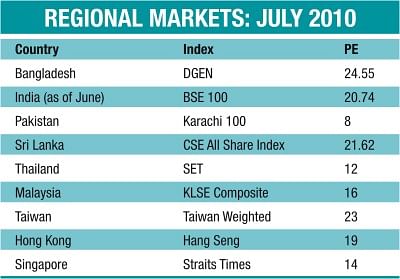Need for new listings

Photo Source: DSE Monthly Review
The average price-earnings (PE) ratio on the Dhaka bourse is the highest among the major regional stockmarkets.
The PE ratio is a company's current share price compared to its earnings per share. In general, a high PE ratio means investors expect higher earnings in future, or there is a strong chance they will be able to make a capital gain by selling the stock. In other words, the value of the share will increase and the investor will be able to sell it for more than what he paid for.
At the end of July, the average PE ratio on the Dhaka Stock Exchange (DSE) stood at 24.55, according to the latest monthly review by the premier bourse.
It means if an investor buys a share of a company on the Dhaka market, it will take 24.55 years on an average before the company earns enough profit to equal the value of the investment.
The PE ratio in India is now just slightly over 20.5, while the ratio is only 8 in Pakistan, 21.62 in Sri Lanka, 12 in Thailand, 16 in Malaysia, 23 in Taiwan, 19 in Hong Kong and 14 in Singapore.
However, a high PE ratio can sometimes be a good indicator of future returns, as investors are overoptimistic in forecasting earnings.
The reason behind the higher PE ratio on the Dhaka bourse is mainly a mismatch between demand and supply. There is a huge demand for new shares now.
Since January, thousands of investors entered the market everyday with crores of taka in cash.
In contrast, the market listed only four new securities, except for some mutual funds and a convertible zero coupon bond, since January.
Investors chase a limited number of shares regardless of the risk factors, thus increasing the PE, as the companies' earnings and share prices do not see matched growth.
Analysts and market operators identify the dearth of new securities as the only reason behind the high market PE.
"It is apparent that the market is being heated due to a dearth of new shares, resulting in a high PE," said Salahuddin Ahmed Khan, professor of finance at Dhaka University.
The government and the market intermediaries should immediately launch a special drive to bring new issues, said Khan, also a former chief executive of the DSE.
"If necessary, the existing rules should also be amended or relaxed so new companies become interested to join the market," he said, referring to the IPO rules.
IPO (initial public offering) rules now allow a company with at least Tk 40 crore paid-up capital, including the IPO offer size; and no company is allowed to offer shares less than 40 percent of its paid-up capital.
Many companies would be willing to list if these rules were relaxed, said issue managers.
However, the Consultative Committee of the Securities and Exchange Commission last week recommended that companies with at least Tk 25 crore in paid-up capital, including the IPO offer size, should be allowed in the market.
The total number of listed securities on the DSE is 452, of which 245 are companies, 26 are mutual funds, eight are debentures, 171 are treasury bonds and two are corporate bonds.
Treasury bonds and the debentures were never traded on the floor, meaning it is an inactive bond market.
"Our stockmarket's PE ratio is the highest among the major regional stockmarkets', and it's because that the investors have no sufficient options," said a merchant banker.
"The investors have to choose investable securities from a little basket," he said, adding that the market is expanding gradually, but the supply side remains poor in comparison with the growing demand of the investors.
A high PE ratio also indicates how much a stockmarket is overpriced, and the July figure showed that the Dhaka market is marching towards an alarming position, said an asset manager.
The regulator stepped in several times during the last couple of months, but succeeded only in cooling the markets briefly.
Each time the market reacted negatively to the cooling measures with record-level falls, and recovered the losses within two days.
Such a failure or the rising trend also reminds that no measures can calm the market in absence of new issues.

 For all latest news, follow The Daily Star's Google News channel.
For all latest news, follow The Daily Star's Google News channel. 



Comments